Unveiling the Nuances: How Fuzzy Set Analysis Illuminates Passenger Preferences for AI and Human Agents in Airline Customer Service
Abstract
1. Introduction
2. Conceptual Background and Hypotheses
2.1. Existing Theoretical Frameworks
2.1.1. Technology Acceptance Model (TAM) and Its Limitations
2.1.2. Emotional Labor Theory in Service Interactions
2.1.3. Trust in Technology and AI Systems
2.1.4. Social Presence Theory and Computers Are Social Actors (CASA) Paradigm
2.2. AI Applications and Passenger Preferences in Airline Customer Service
2.2.1. Current and Emerging Applications of AI in Airline Customer Service
- AI-powered chatbots and virtual assistants: Used for flight bookings, inquiries, and check-ins (e.g., Southwest Airlines’ chatbot for rebookings) (Helmrich et al., 2023).
- Personalized recommendations: Tailored offers based on passenger preferences (Duca et al., 2022).
- Predictive analytics: Anticipating and addressing flight disruptions (Helmrich et al., 2023).
- Self-service technologies: AI-driven kiosks and airport wayfinding systems.
2.2.2. The Nuances of Passenger Experience and the Persistent Need for Human Agency
2.2.3. Towards a Hybrid Service Model
2.3. Hypotheses Development and Theoretical Justification
3. Research Method
3.1. Research Design: A Mixed-Methods Approach
3.2. Participants and Sampling Procedure
3.3. Data Collection Instrument and Procedure
3.4. Data Analysis Techniques
3.4.1. Quantitative Data Analysis
3.4.2. Fuzzy Set Data Analysis
3.5. Control Variables and Validity Assessments
3.5.1. Control Variables
3.5.2. Validity Assessments
3.6. Ethical Considerations
4. Analysis Results
4.1. Descriptive and Correlation Analyses
4.2. Regression Analysis: Predictors of Satisfaction and Trust
4.2.1. Predictors of Satisfaction with AI Services
- Perceived Benefits Score (β = 0.56, p < 0.001)
- Complexity Score (β = −0.17, p < 0.05)
- Compatibility Score (β = 0.18, p < 0.05)
4.2.2. Predictors of Trust in AI Interactions
- Perceived Benefits Score (β = 0.54, p < 0.001)
- Complexity Score (β = −0.23, p < 0.01)
4.3. Fuzzy Set Analysis: Nuances in Passenger Preferences
4.4. Additional Visualizations and Endogeneity Check
4.5. Summary
- Scenario Effects (Hypotheses 1 and 2)
- AI is favored for routine, transactional tasks; human-led services dominate in emotionally charged or high-complexity scenarios.
- Regression Insights
- Perceived benefits and complexity significantly drive satisfaction and trust, indirectly supporting Hypothesis 4 and directly confirming Hypothesis 6. Compatibility specifically boosts satisfaction, while complexity reduces both satisfaction and trust.
- Fuzzy Nuance (Hypothesis 7)
- Fuzzy membership overlaps reveal partial AI and human orientation, affirming the necessity of a hybrid approach. Dissatisfaction with AI in complex contexts backs Hypothesis 5, and emotional labor considerations tie to Hypothesis 3.
- Robustness
- The Durbin–Wu–Hausman test showed no major endogeneity, indicating stable results from both regression and fuzzy models.
5. Discussion
5.1. Theoretical Implications
5.2. Practical Implications
5.3. Study Limitations and Future Research Directions
6. Conclusions
Author Contributions
Funding
Institutional Review Board Statement
Informed Consent Statement
Data Availability Statement
Conflicts of Interest
References
- Alamá-Sabater, L., Budí, V., García-Álvarez-Coque, J. M., & Roig-Tierno, N. (2019). Using mixed research approaches to understand rural depopulation. Economía Agraria y Recursos Naturales, 19(1), 99. [Google Scholar] [CrossRef]
- Authayarat, W., & Umemuro, H. (2012). Affective management and its effects on management performance. Journal of Entrepreneurship, Management and Innovation, 8(2), 5–25. [Google Scholar] [CrossRef]
- Åkerblad, L., Seppänen-Järvelä, R., & Haapakoski, K. (2020). Integrative strategies in mixed methods research. Journal of Mixed Methods Research, 15(2), 152–170. [Google Scholar] [CrossRef]
- Barbera, J., Naibert, N., Komperda, R., & Pentecost, T. C. (2020). Clarity on cronbach’s alpha use. Journal of Chemical Education, 98(2), 257–258. [Google Scholar] [CrossRef]
- Baruch, H. (2025). AI in the travel industry: How AI can transform airline customer support. Available online: https://www.bland.ai/blogs/ai-travel-industry-airline-customer-support (accessed on 5 January 2025).
- Bondarenko, A., Shirshakova, E., & Hagen, M. (2022, March 14–18). A user study on clarifying comparative questions. CHIIR ’22: ACM SIGIR Conference on Human Information Interaction and Retrieval, Regensburg, Germany. [Google Scholar]
- Buha, V., Lečić, R., & Berezljev, L. (2024). Transformation of business under the influence of artificial intelligence. Trendovi u Poslovanju, 12(1), 9–19. [Google Scholar] [CrossRef]
- Cheong, B. C. (2024). Transparency and accountability in AI systems: Safeguarding wellbeing in the age of algorithmic decision-making. Frontiers in Human Dynamics, 6, 1421273. [Google Scholar] [CrossRef]
- Chi, N. T. K., & Hoang Vu, N. (2022). Investigating the customer trust in artificial intelligence: The role of anthropomorphism, empathy response, and interaction. CAAI Transactions on Intelligence Technology, 8(1), 260–273. [Google Scholar] [CrossRef]
- Dahlberg, T., Mallat, N., & Öörni, A. (2003). Trust enhanced technology acceptance model-consumer acceptance of mobile payment solutions: Tentative evidence. Stockholm Mobility Roundtable, 22, 145. [Google Scholar]
- Davis, F. D., Bagozzi, R. P., & Warshaw, P. R. (1989). User acceptance of computer technology: A comparison of two theoretical models. Management Science, 35(8), 982–1003. [Google Scholar] [CrossRef]
- Di Nardo, E., & Simone, R. (2018). A model-based fuzzy analysis of questionnaires. Statistical Methods & Applications, 28(2), 187–215. [Google Scholar] [CrossRef]
- Dosek, T. (2021). Snowball sampling and facebook: How social media can help access hard-to-reach populations. PS: Political Science & Politics, 54(4), 651–655. [Google Scholar] [CrossRef]
- Dragan, I.-M., & Isaic-Maniu, A. (2022). An original solution for completing research through snowball sampling—Handicapping method. Advances in Applied Sociology, 12(11), 729–746. [Google Scholar] [CrossRef]
- Duca, G., Trincone, B., Bagamanova, M., Meincke, P., Russo, R., & Sangermano, V. (2022). Passenger dimensions in sustainable multimodal mobility services. Sustainability, 14(19), 12254. [Google Scholar] [CrossRef]
- Ellerby, Z., Wagner, C., & Broomell, S. B. (2022). Capturing richer information: On establishing the validity of an interval-valued survey response mode. Behavior Research Methods, 54(3), 1240–1262. [Google Scholar] [CrossRef] [PubMed]
- Erlei, A., Das, R., Meub, L., Anand, A., & Gadiraju, U. (2022, April 29–May 5). For what it’s worth: Humans overwrite their economic self-interest to avoid bargaining with AI systems. CHI ’22: Proceedings of the 2022 CHI Conference on Human Factors in Computing Systems, New Orleans, LA, USA. [Google Scholar]
- Feldman, A., & Grant-Smith, D. (2022). Fuzzy set qualitative comparative analysis: Application of fuzzy sets in the social sciences. In S. Broumi (Ed.), Advances in computer and electrical engineering (pp. 50–76). IGI Global. [Google Scholar] [CrossRef]
- Franzoni, V. (2023). From black box to glass box: Advancing transparency in artificial intelligence systems for ethical and trustworthy AI. In O. Gervasi, B. Murgante, A. M. A. C. Rocha, C. Garau, F. Scorza, Y. Karaca, & C. M. Torre (Eds.), Computational science and its applications—ICCSA 2023 workshops (Vol. 14107, pp. 118–130). Springer Nature Switzerland. [Google Scholar] [CrossRef]
- Frasch, M. G. (2022). Comprehensive HRV estimation pipeline in Python using Neurokit2: Application to sleep physiology. MethodsX, 9, 101782. [Google Scholar] [CrossRef]
- Gholami, M. H., & Esfahani, M. S. (2019). An integrated analytical framework based on fuzzy DEMATEL and fuzzy ANP for competitive market strategy selection. International Journal of Industrial and Systems Engineering, 31(2), 137. [Google Scholar] [CrossRef]
- Guerrini, A., Ferri, G., Rocchi, S., Cirelli, M., Piña, V., & Grieszmann, A. (2023). Personalization @ scale in airlines: Combining the power of rich customer data, experiential learning, and revenue management. Journal of Revenue and Pricing Management, 22(2), 171–180. [Google Scholar] [CrossRef]
- Gurjar, K., Jangra, A., Baber, H., Islam, M., & Sheikh, S. A. (2024). An analytical review on the impact of artificial intelligence on the business industry: Applications, trends, and challenges. IEEE Engineering Management Review, 52(2), 84–102. [Google Scholar] [CrossRef]
- Hanif, A. H. M., & Jaafar, A. G. (2023). A review: Application of big data analytics in airlines industry. Open International Journal of Informatics, 11(2), 196–209. [Google Scholar] [CrossRef]
- He, Y., Liao, L., Zhang, Z., & Chua, T.-S. (2021, October 20). Towards enriching responses with crowd-sourced knowledge for task-oriented dialogue. MuCAI’21: Proceedings of the 2nd ACM Multimedia Workshop on Multimodal Conversational AI, Virtual Event, China. [Google Scholar]
- Helmrich, A., Chester, M., & Ryerson, M. (2023). Complexity of increasing knowledge flows: The 2022 southwest airlines scheduling crisis. Environmental Research: Infrastructure and Sustainability, 3(3), 033001. [Google Scholar] [CrossRef]
- Hendricks-Sturrup, R. M., Zhang, F., & Lu, C. Y. (2022). A survey of research participants’ privacy-related experiences and willingness to share real-world data with researchers. Journal of Personalized Medicine, 12(11), 1922. [Google Scholar] [CrossRef]
- Hersh, H. M., & Caramazza, A. (1976). A fuzzy set approach to modifiers and vagueness in natural language. Journal of Experimental Psychology: General, 105(3), 254–276. [Google Scholar] [CrossRef]
- Ho, C., Martin, M., Taneja, D., West, D. S., Boro, S., & Jackson, C. (2022). Combating bias in AI and machine learning in consumer-facing services. In L. A. DiMatteo, C. Poncibò, & M. Cannarsa (Eds.), The cambridge handbook of artificial intelligence (1st ed., pp. 364–382). Cambridge University Press. [Google Scholar] [CrossRef]
- Hochschild, A. R. (1979). Emotion work, feeling rules, and social structure. American Journal of Sociology, 85(3), 551–575. [Google Scholar] [CrossRef]
- Horovitz, J. H. (1980). Management control and associated variables. In Top management control in Europe (pp. 23–37). Palgrave Macmillan UK. [Google Scholar] [CrossRef]
- Hökkä, P., Vähäsantanen, K., & Ikävalko, H. (2022). An integrative approach to emotional agency at work. Vocations and Learning, 16(1), 23–46. [Google Scholar] [CrossRef]
- Hsu, C.-L., & Lin, J. C.-C. (2023). Understanding the user satisfaction and loyalty of customer service chatbots. Journal of Retailing and Consumer Services, 71, 103211. [Google Scholar] [CrossRef]
- Ivanov, D., Pelipenko, E., Ershova, A., & Tick, A. (2023). Artificial intelligence in aviation industry. In I. Ilin, C. Jahn, & A. Tick (Eds.), Digital technologies in logistics and infrastructure (Vol. 157, pp. 233–245). Springer International Publishing. [Google Scholar] [CrossRef]
- Kim, T. W., Jiang, L., Duhachek, A., Lee, H., & Garvey, A. (2022). Do you mind if I ask you a personal question? How AI service agents alter consumer self-disclosure. Journal of Service Research, 25(4), 649–666. [Google Scholar] [CrossRef]
- Klarmann, M., & Feurer, S. (2018). Control variables in marketing research. Marketing ZFP, 40(2), 26–40. [Google Scholar] [CrossRef]
- Kyriazos, T., & Poga, M. (2023). Dealing with multicollinearity in factor analysis: The problem, detections, and solutions. Open Journal of Statistics, 13(03), 404–424. [Google Scholar] [CrossRef]
- Lam, W. H., Lam, W. S., Liew, K. F., & Lee, P. F. (2023). Decision analysis on the financial performance of companies using integrated entropy-fuzzy TOPSIS model. Mathematics, 11(2), 397. [Google Scholar] [CrossRef]
- Landry, S. J. (2012). Human-computer interaction in aerospace. In J. A. Jacko (Ed.), The human–computer interaction handbook (3rd ed., pp. 771–793). CRC Press. [Google Scholar] [CrossRef]
- Li, W., Shen, S., Yang, J., Guo, J., & Tang, Q. (2022). Determinants of satisfaction with hospital online appointment service among older adults during the COVID-19 pandemic: A cross-sectional study. Frontiers in Public Health, 10, 853489. [Google Scholar] [CrossRef]
- Li, Z. (2024). AI ethics and transparency in operations management: How Governance mechanisms can reduce data bias and privacy risks. Journal of Applied Economics and Policy Studies, 13(1), 89–93. [Google Scholar] [CrossRef]
- Liu, X., & Sun, S. (2023, March 24–26). A subjective questionnaire system based on privacy-friendly incentive protocols. 2023 2nd International Symposium on Computer Applications and Information Systems (ISCAIS 2023), Chengdu, China. [Google Scholar]
- Lubiano, M. A., de la Rosa de Sáa, S., Montenegro, M., Sinova, B., & Gil, M. Á. (2016). Descriptive analysis of responses to items in questionnaires. Why not using a fuzzy rating scale? Information Sciences, 360, 131–148. [Google Scholar] [CrossRef]
- Lynch, T. (2019). Methodology: Research design and analysis of data. In Physical education and wellbeing (pp. 127–142). Springer International Publishing. [Google Scholar] [CrossRef]
- Mabotja, T., & Ngcobo, N. (2024). Navigating emotional labour: The role of deep acting in enhancing job performance and customer relations in the South African racecourse industry. International Journal of Research in Business and Social Science, 13(5), 324–334. [Google Scholar] [CrossRef]
- McCann, K. (2025). How AI is transforming the airline industry. AI Magazine. Available online: https://aimagazine.com/articles/how-ai-is-transforming-the-airline-industry (accessed on 26 February 2025).
- McKee, K. R., Bai, X., & Fiske, S. T. (2024). Warmth and competence in human-agent cooperation. Autonomous Agents and Multi-Agent Systems, 38(1), 23. [Google Scholar] [CrossRef]
- Mednick, M. T. (1985). The managed heart: Commercialization of human feeling. Theory and Society, 13, 731–736. [Google Scholar] [CrossRef]
- Nass, C., Steuer, J., & Tauber, E. R. (1994, April 24–28). Computers are social actors. Proceedings of the SIGCHI Conference on Human Factors in Computing Systems, Boston, MA, USA. [Google Scholar]
- Naumov, V., Zhamanbayev, B., Agabekova, D., Zhanbirov, Z., & Taran, I. (2021). Fuzzy-logic approach to estimate the passengers’ preference when choosing a bus line within the public transport system. Communications-Scientific Letters of the University of Zilina, 23(3), A150–A157. [Google Scholar] [CrossRef]
- Oubahman, L., & Duleba, S. (2023). Fuzzy PROMETHEE model for public transport mode choice analysis. Evolving Systems, 15(2), 285–302. [Google Scholar] [CrossRef]
- Perneger, T. V., Peytremann-Bridevaux, I., & Combescure, C. (2020). Patient satisfaction and survey response in 717 hospital surveys in Switzerland: A cross-sectional study. BMC Health Services Research, 20(1), 158. [Google Scholar] [CrossRef]
- Sagirli, F. Y., Zhao, X., & Wang, Z. (2024). Human-computer interaction and human-ai collaboration in advanced air mobility: A comprehensive review. arXiv, arXiv:2412.07241. [Google Scholar] [CrossRef]
- Seymour, M., Yuan, L., Dennis, A., & Riemer, K. (2020, January 7–10). Facing the artificial: Understanding affinity, trustworthiness, and preference for more realistic digital humans. Proceedings of the 53rd Hawaii International Conference on System Sciences, Maui, HI, USA. [Google Scholar] [CrossRef]
- Shen, P., Wan, D., & Zhu, A. (2024). Investigating the effect of AI service quality on consumer well-being in retail context. Service Business, 19(1), 5. [Google Scholar] [CrossRef]
- Shiwakoti, N., Hu, Q., Pang, M. K., Cheung, T. M., Xu, Z., & Jiang, H. (2022). Passengers’ perceptions and satisfaction with digital technology adopted by airlines during COVID-19 pandemic. Future Transportation, 2(4), 988–1009. [Google Scholar] [CrossRef]
- Short, J., Williams, E., & Christie, B. (1976). The social psychology of telecommunications. Wiley. Available online: https://books.google.fr/books?id=Ze63AAAAIAAJ (accessed on 26 February 2025).
- Singh, S. P., & Singh, P. (2018). An integrated AFS-based SWOT analysis approach for evaluation of strategies under MCDM environment. Journal of Operations and Strategic Planning, 1(2), 129–147. [Google Scholar] [CrossRef]
- Sohn, Y., Son, S., & Lim, Y.-K. (2023, July 10–14). Exploring passengers’ experiences in algorithmic dynamic ride-pooling services. DIS ’23 Companion: Companion Publication of the 2023 ACM Designing Interactive Systems Conference, Pittsburgh, PA, USA. [Google Scholar]
- Sousa, A. E., Cardoso, P., & Dias, F. (2024). The use of artificial intelligence systems in tourism and hospitality: The tourists’ perspective. Administrative Sciences, 14(8), 165. [Google Scholar] [CrossRef]
- Susanto, E., & Khaq, Z. D. (2024). Enhancing customer service efficiency in start-ups with ai: A focus on personalization and cost reduction. Journal of Management and Informatics, 3(2), 267–281. [Google Scholar] [CrossRef]
- Truran, W. J. (2022). Affect theory. In The routledge companion to literature and emotion (1st ed., pp. 26–37). Routledge. [Google Scholar] [CrossRef]
- Ugural, M., & Giritli, H. (2021). Three-way interaction model for turnover intention of construction professionals: Some evidence from Turkey. Journal of Construction Engineering and Management, 147(4), 04021008. [Google Scholar] [CrossRef]
- Ugural, M. N., Aghili, S., & Burgan, H. I. (2024). Adoption of lean construction and AI/IoT technologies in iran’s public construction sector: A mixed-methods approach using fuzzy logic. Buildings, 14(10), 3317. [Google Scholar] [CrossRef]
- Van Den Hoven Van Genderen, R., Ballardini, R. M., & Corrales Compagnucci, M. (2022). AI innovations, empathy and the law. In Empathy and business transformation (1st ed., pp. 277–290). Routledge. [Google Scholar] [CrossRef]
- Vevere, V., Dange, K., Linina, I., & Zvirgzdina, R. (2024). Integration of artificial intelligence (AI) within SmartLynx airlines to increase operational efficiency. Wseas Transactions on Business and Economics, 21, 1677–1683. [Google Scholar] [CrossRef]
- Wang, H.-I., Manolas, C., & Xanthidis, D. (2022). Statistical analysis with Python. In Handbook of computer programming with Python (1st ed., pp. 373–408). Chapman and Hall/CRC. [Google Scholar] [CrossRef]
- Wu, M.-J., Zhao, K., & Fils-Aime, F. (2022). Response rates of online surveys in published research: A meta-analysis. Computers in Human Behavior Reports, 7, 100206. [Google Scholar] [CrossRef]

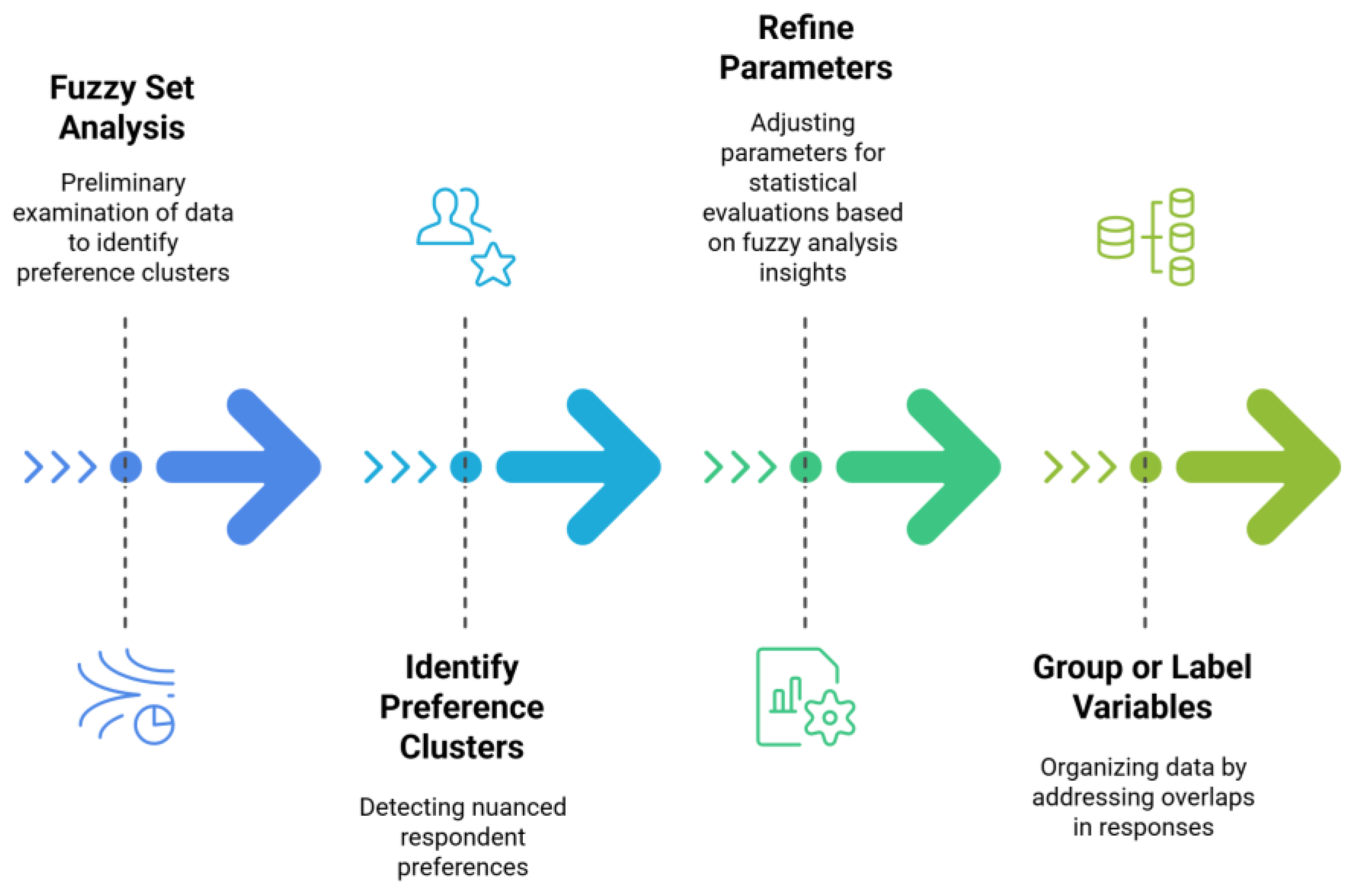
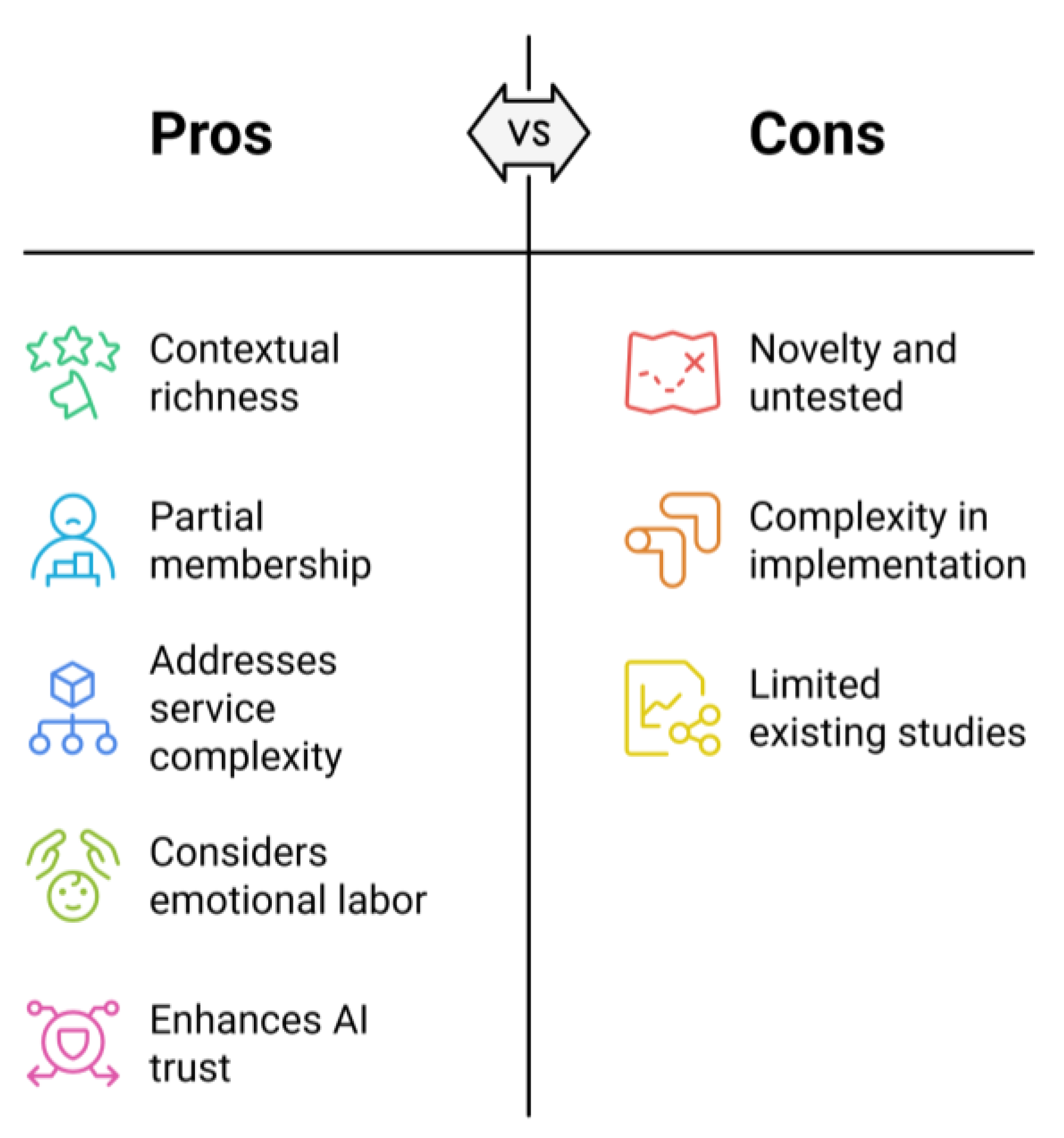


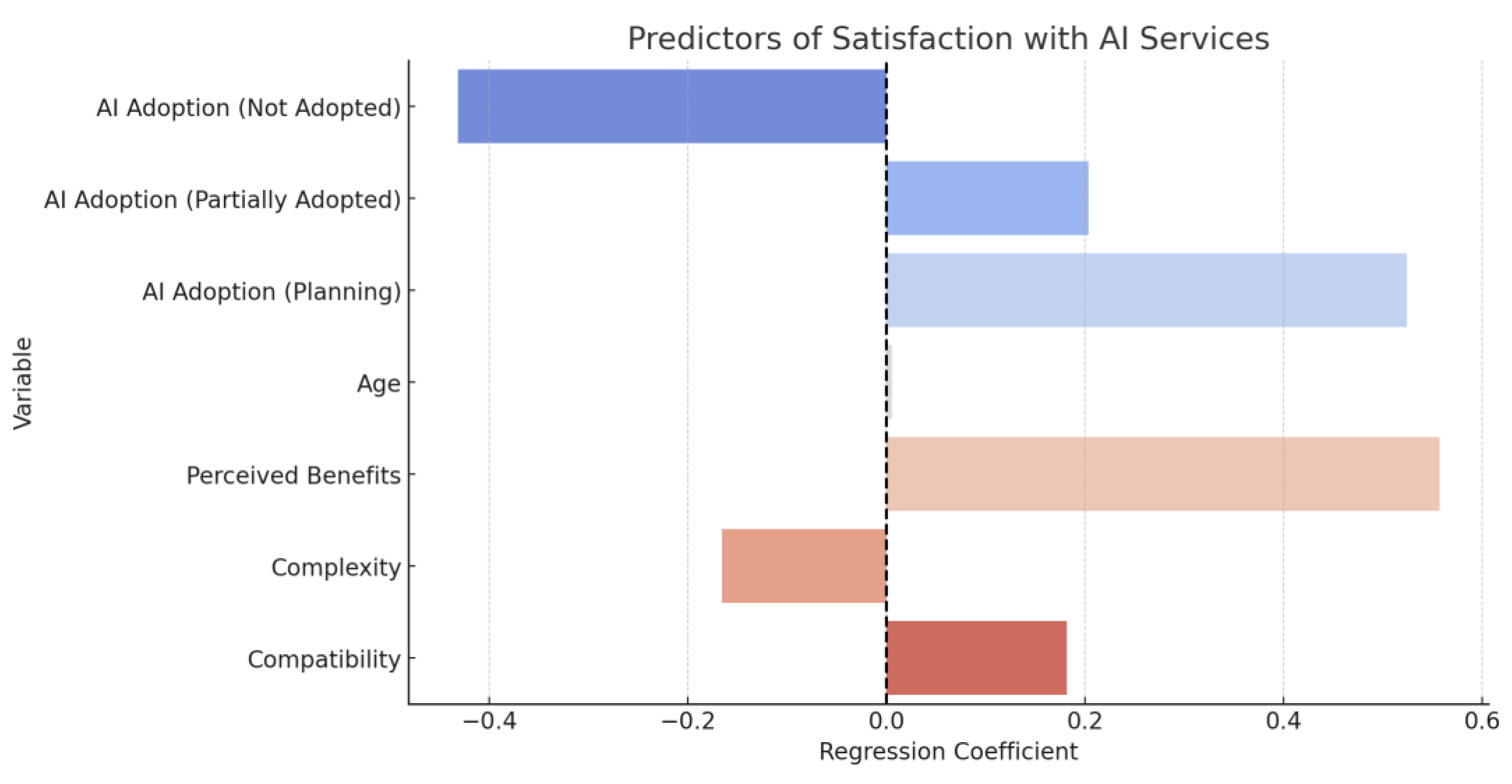
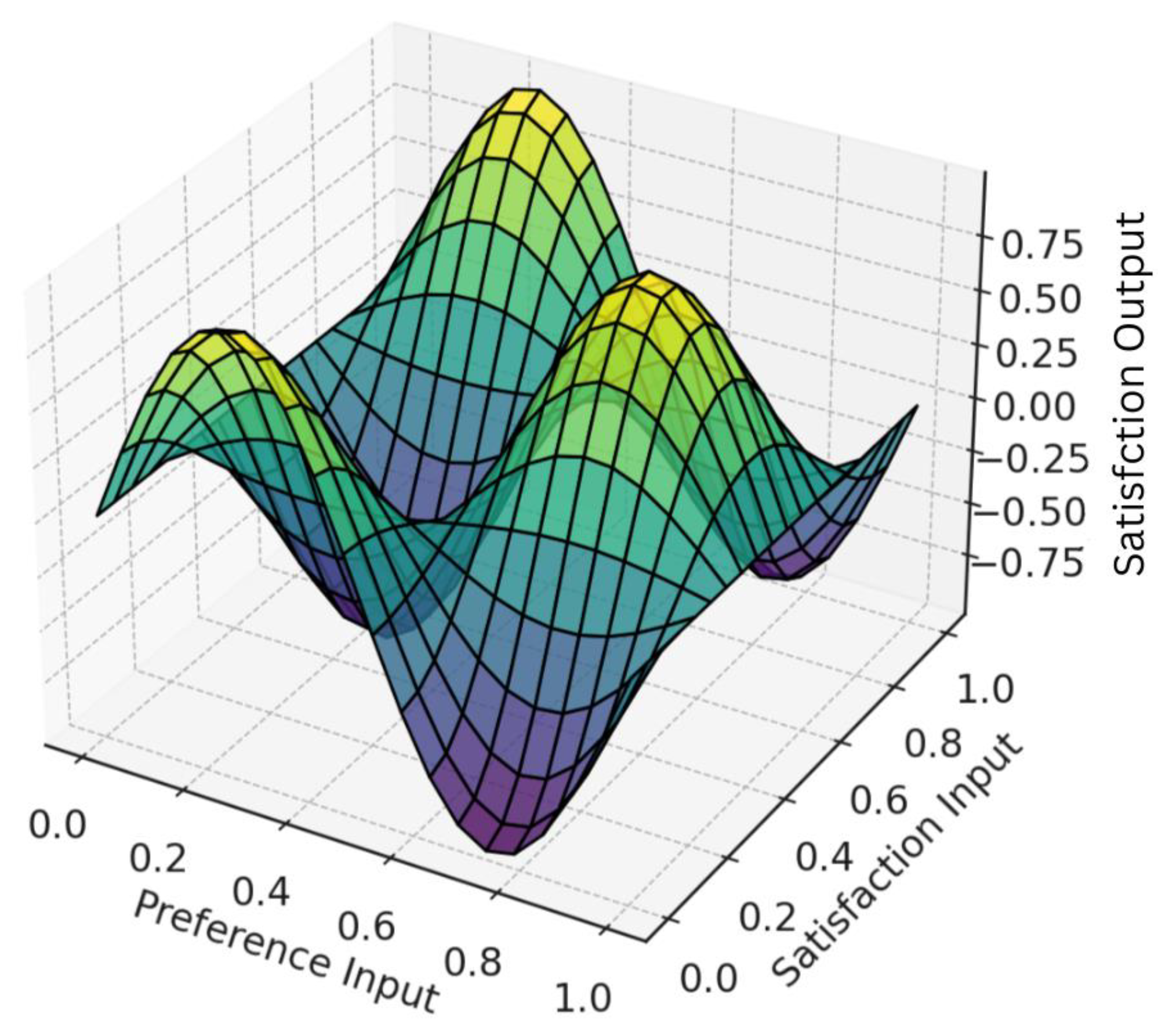
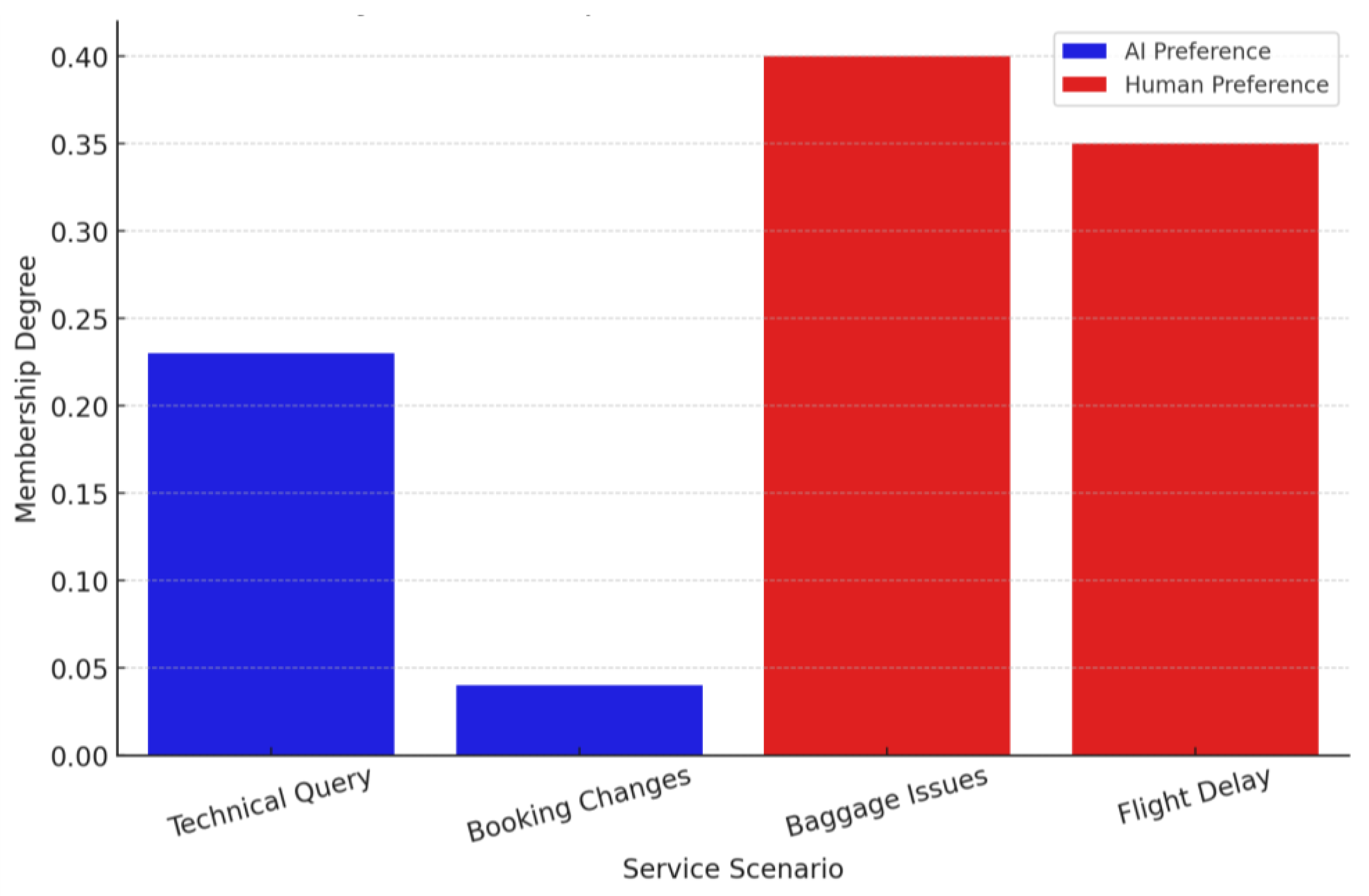

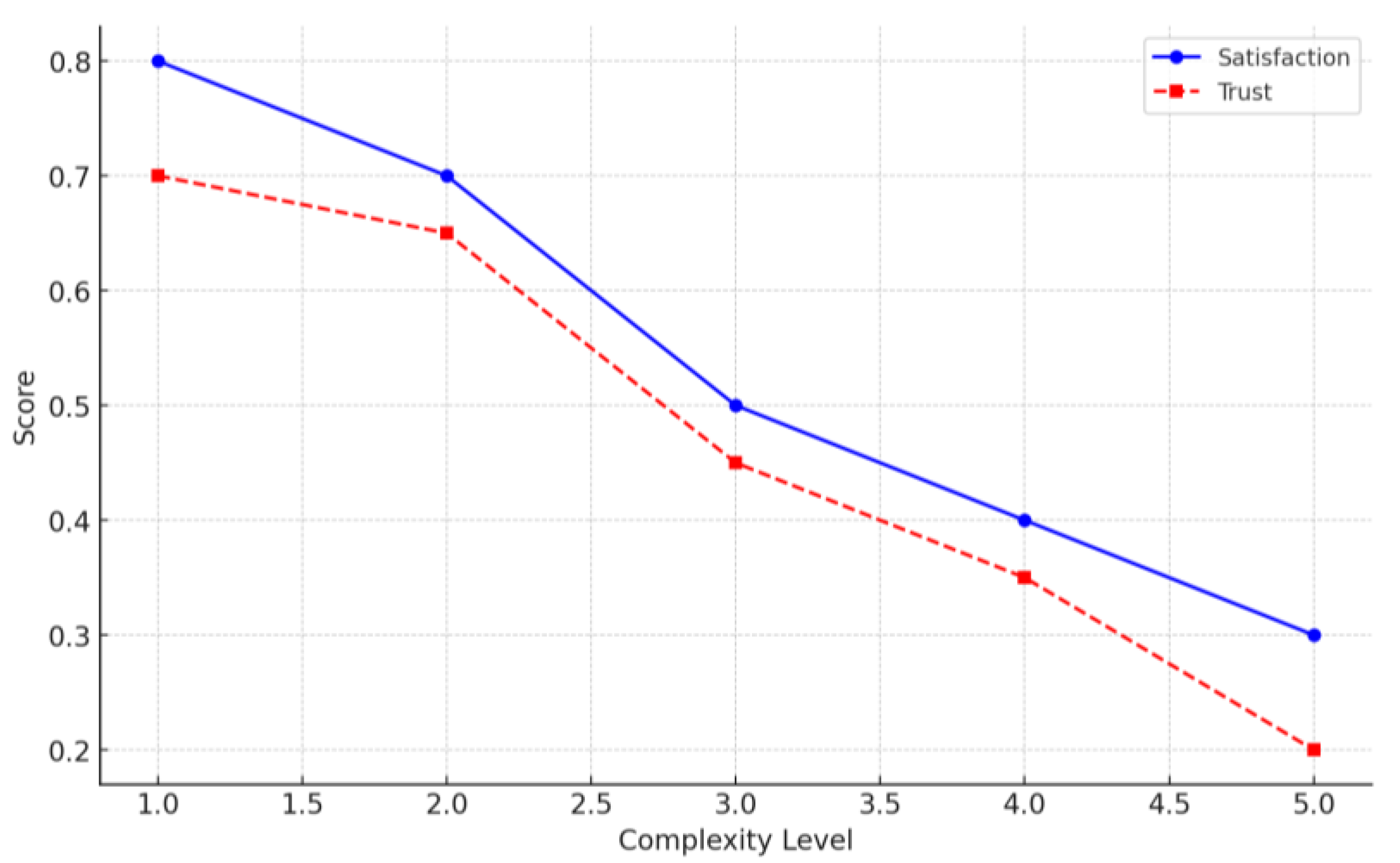
| Characteristic | Category | N | Percentage (%) |
|---|---|---|---|
| Age | 18–24 | 25 | 15.3% |
| Age | 25–34 | 55 | 33.7% |
| Age | 35–44 | 45 | 27.6% |
| Age | 45–54 | 23 | 14.1% |
| Age | 55+ | 15 | 9.2% |
| Gender | Male | 85 | 52.1% |
| Gender | Female | 78 | 47.9% |
| Education Level | High School | 18 | 11.0% |
| Education Level | Bachelor’s Degree | 107 | 65.6% |
| Education Level | Master’s Degree | 30 | 18.4% |
| Education Level | Doctoral Degree | 8 | 4.9% |
| Flights Annually | 0–2 | 40 | 24.5% |
| Flights Annually | 3–5 | 75 | 46.0% |
| Flights Annually | 6+ | 48 | 29.4% |
| AI Experience | Yes | 127 | 78.0% |
| AI Experience | No | 36 | 22.0% |
| Scenario | AI Preference | Human Preference | Hybrid Preference |
|---|---|---|---|
| Baggage Issues | 0.0818 | 0.5727 | 0.3455 |
| Booking Changes | 0.3125 | 0.3125 | 0.3750 |
| Flight Delay | 0.2182 | 0.4727 | 0.3091 |
| Technical Query | 0.4388 | 0.1939 | 0.3673 |
| Variable | Coefficient (Satisfaction) | Standard Error (Satisfaction) | p-Value (Satisfaction) | Coefficient (Trust) | Standard Error (Trust) | p-Value (Trust) |
|---|---|---|---|---|---|---|
| Intercept | −1.5046 | 0.901 | 0.097 | −1.1565 | 0.918 | 0.209 |
| AI Adoption (Not Adopted) | −0.4319 | 0.468 | 0.358 | −0.5400 | 0.477 | 0.259 |
| AI Adoption (Partially Adopted) | 0.2037 | 0.305 | 0.505 | −0.0058 | 0.311 | 0.985 |
| AI Adoption (Planning) | 0.5243 | 0.303 | 0.085 | 0.2974 | 0.309 | 0.338 |
| Age | 0.0057 | 0.009 | 0.540 | 0.0076 | 0.009 | 0.413 |
| Perceived Benefits | 0.5567 | 0.089 | <0.001 *** | 0.5426 | 0.090 | <0.001 *** |
| Complexity | −0.1659 | 0.078 | 0.035 * | −0.2254 | 0.079 | 0.005 ** |
| Compatibility | 0.1813 | 0.077 | 0.019 * |
| Scenario | Rule 1 | Rule 2 |
|---|---|---|
| Technical Query | 0.23 | 0.00 |
| Booking Changes | 0.04 | 0.00 |
| Baggage Issues | 0.00 | 0.40 |
| Flight Delay | 0.00 | 0.35 |
Disclaimer/Publisher’s Note: The statements, opinions and data contained in all publications are solely those of the individual author(s) and contributor(s) and not of MDPI and/or the editor(s). MDPI and/or the editor(s) disclaim responsibility for any injury to people or property resulting from any ideas, methods, instructions or products referred to in the content. |
© 2025 by the authors. Licensee MDPI, Basel, Switzerland. This article is an open access article distributed under the terms and conditions of the Creative Commons Attribution (CC BY) license (https://creativecommons.org/licenses/by/4.0/).
Share and Cite
Sağbaş, M.; Aydogan, S. Unveiling the Nuances: How Fuzzy Set Analysis Illuminates Passenger Preferences for AI and Human Agents in Airline Customer Service. Tour. Hosp. 2025, 6, 43. https://doi.org/10.3390/tourhosp6010043
Sağbaş M, Aydogan S. Unveiling the Nuances: How Fuzzy Set Analysis Illuminates Passenger Preferences for AI and Human Agents in Airline Customer Service. Tourism and Hospitality. 2025; 6(1):43. https://doi.org/10.3390/tourhosp6010043
Chicago/Turabian StyleSağbaş, Murat, and Sefer Aydogan. 2025. "Unveiling the Nuances: How Fuzzy Set Analysis Illuminates Passenger Preferences for AI and Human Agents in Airline Customer Service" Tourism and Hospitality 6, no. 1: 43. https://doi.org/10.3390/tourhosp6010043
APA StyleSağbaş, M., & Aydogan, S. (2025). Unveiling the Nuances: How Fuzzy Set Analysis Illuminates Passenger Preferences for AI and Human Agents in Airline Customer Service. Tourism and Hospitality, 6(1), 43. https://doi.org/10.3390/tourhosp6010043







